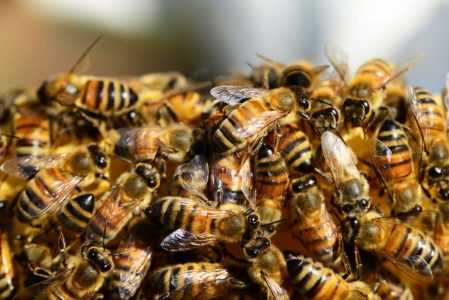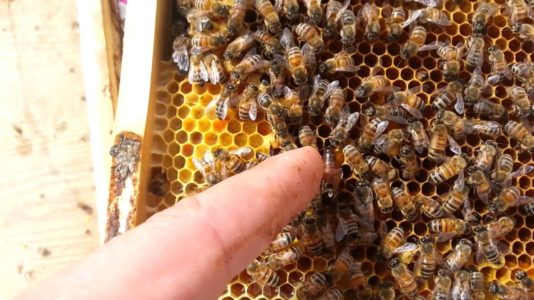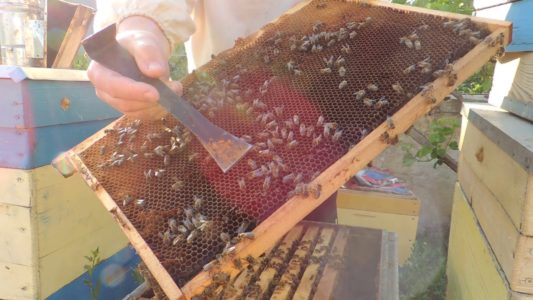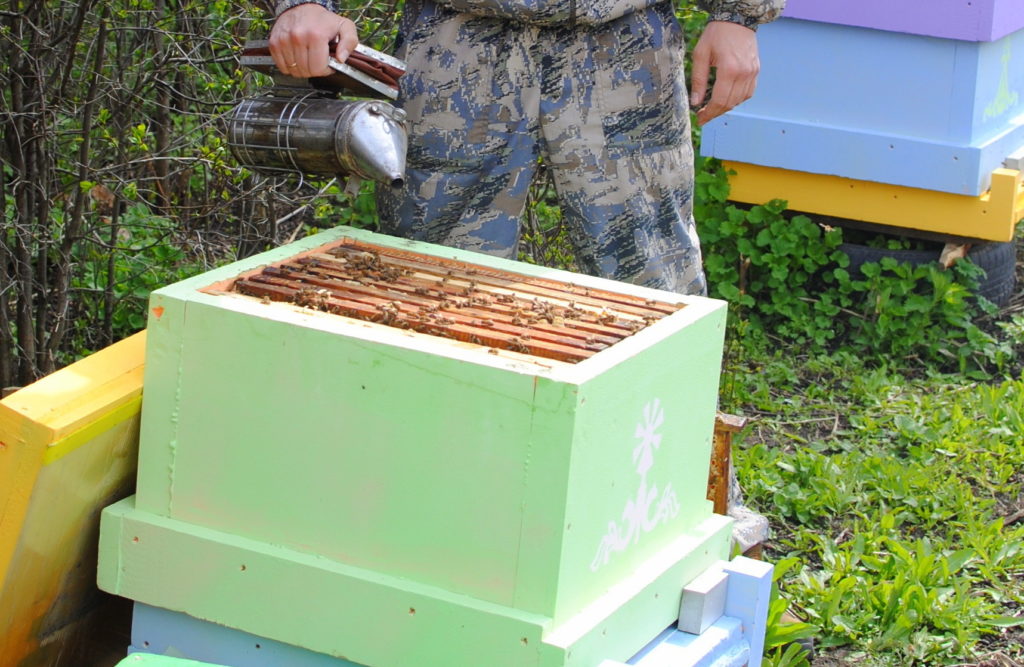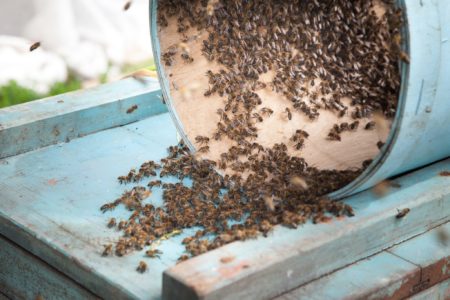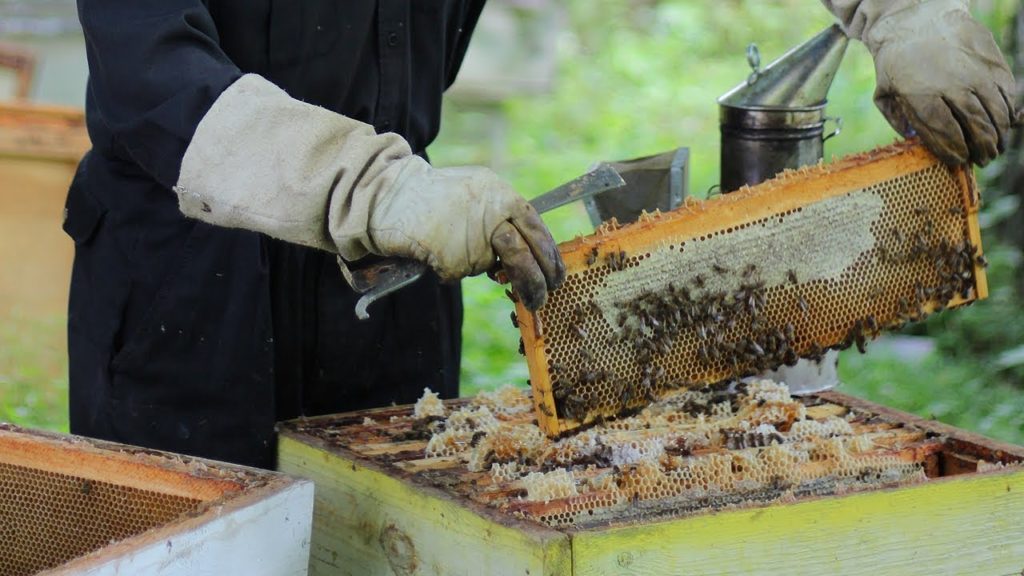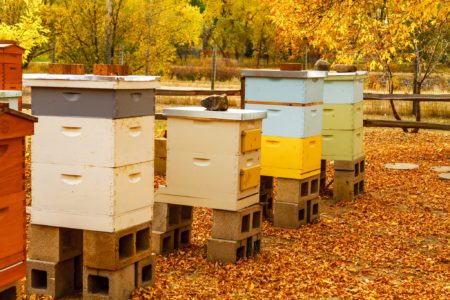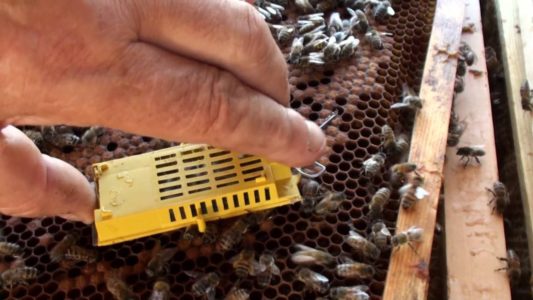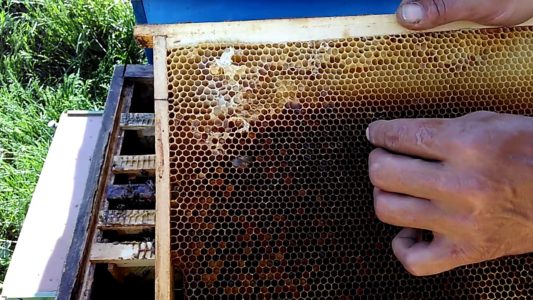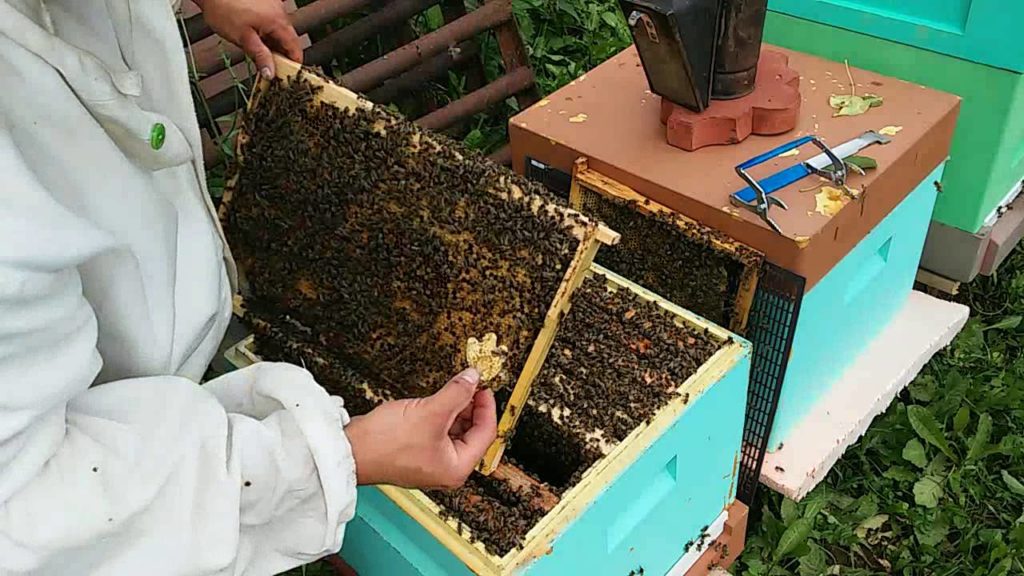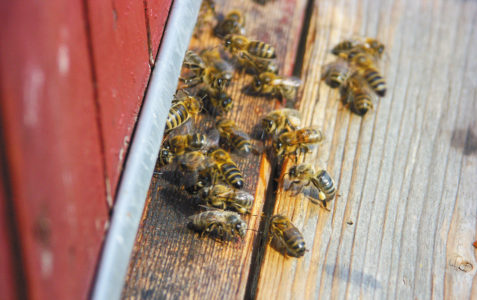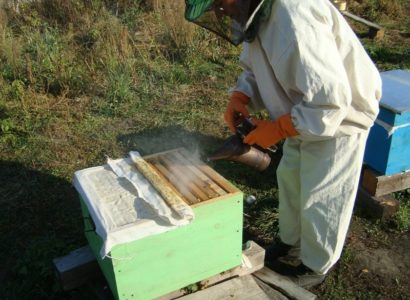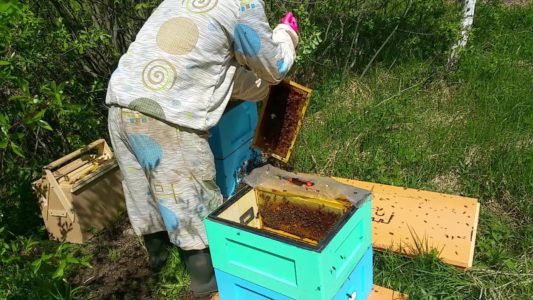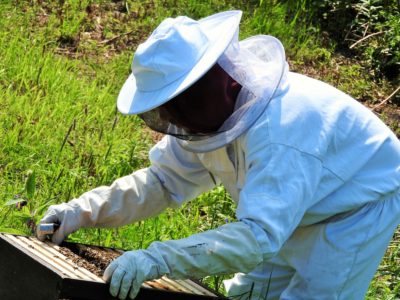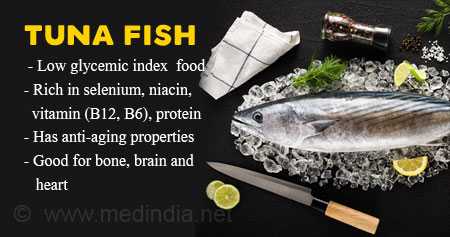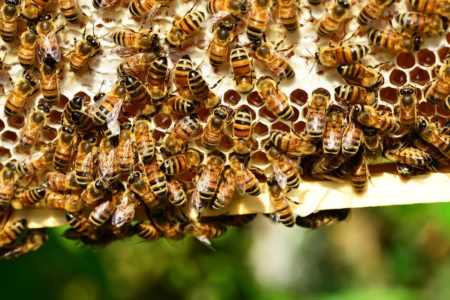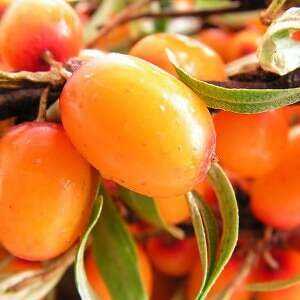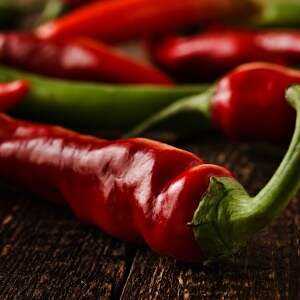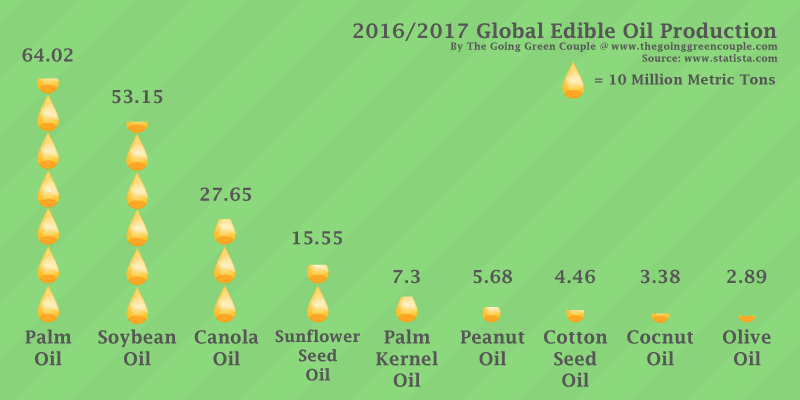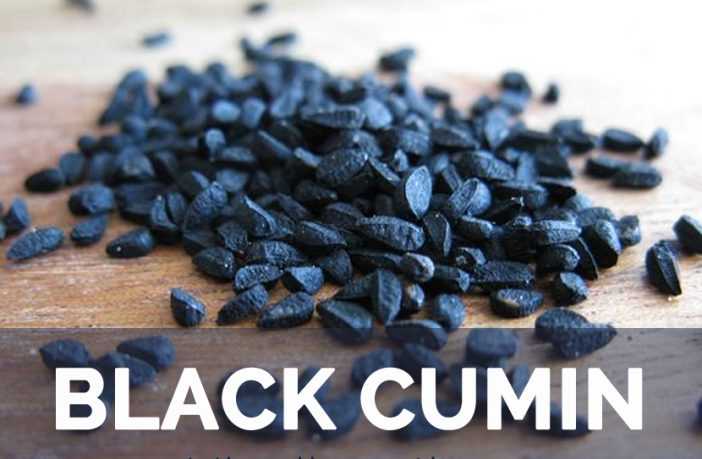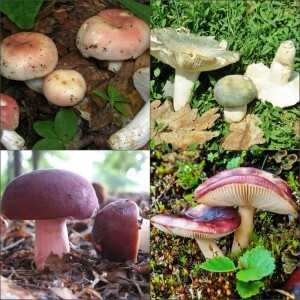Many natural processes occurring in the families of honey insects need to be monitored by beekeepers, managed or stopped in time. These include the swarming of bees, which most often begins at the wrong moment, reduces the productivity of the apiary, if preventive measures have not been taken. The beekeeper is faced with swarming every year and must be prepared for it.
What is bee swarming
With the onset of certain conditions in late spring or summer, the inhabitants of the hive reduce their production of pollen and nectar. Then young strong bees, following the queen, fly out in search of a new home. This process is called swarming. The other part of the family remains to breed a new female, gradually increase the number.
A swarm of bees that has left the home must be caught in time so as not to lose many young insects. The beekeeper should know the prerequisites for swarming bees and the measures to prevent it when the process is undesirable. Learning to encourage insects to divide under control if new layers are needed will come in handy.
What happens while swarming
The bees line up the honeycomb cells in advance to breed new queens. After the eggs are laid, they are sealed. A week later, if the weather is warm, calm, swarming occurs. The family is divided into 2 halves.
The old queen leaves the hive through the entrance, accompanied by worker bees (most of them are young, not older than 1 month) with goiter full of honey and several drones. It takes 5-10 minutes for Roy to be outside the house. A delayed flight is often headed by one of the new females.
Reference!
Before swarming, worker bees stop feeding the queen with special food. She switches to self-feeding with honey, therefore, the size of her abdomen decreases. The emaciated female is able to make a short flight.
Usually, a swarm of bees that has recently left the hive settles in a dense group on the branches of a bush or tree and sends several scouts in search of a suitable dwelling. After 2-3 hours, the insects will fly away to another place.
In the former hive, young queens and worker bees emerge from the brood. They can also fly away, but the number of individuals will be less than during the first swarm. The remaining female destroys all rivals, copulates with drones and lays eggs. The thinned family returns to the construction of honeycombs, extraction of nectar.
Signs of swarming bees
Preparation of honey insects begins 10-14 days before departure from the hive. If, when examining the frames, the beekeeper notices rebuilt queen cells (enlarged cells of the honeycomb where future “queens” develop), a sharp increase in the number of drone larvae in comparison with young workers, the family will soon split.
The upcoming swarming can be judged by the changed behavior of the bees:
- rarely fly out for prey, in the late afternoon they go to inspect the areas adjacent to the apiary;
- sit in large groups on frames, hive walls, worry and make a loud noise;
- workers widen the tap hole, removing part of the propolis from it.
A young uterus emerging from an egg begins to overlap with its competitors sitting in sealed honeycomb cells. Sometimes an old female can give a voice. An experienced beekeeper recognizes these sounds, determining from them the imminent onset of separation.
Swarming reasons
Bees are driven by instincts to lay queen cells and send half of the family in search of a new home. This is their way of reproduction and reaction to unfavorable living conditions. Preparations for departure can begin for the following reasons:
- there is no place in the hive for stocks, egg-laying;
- inaction of some of the worker bees;
- aging of the uterus;
- poor ventilation.
Some breeds of melliferous insects are more prone to swarming. Preventive measures delay family separation, but it can still happen when the conditions are right.
Swarming due to overpopulation
The signal to prepare for the release of layering for bees is the lack of space in the hive for their needs. Working productively, insects fill cells with nectar and pollen in almost all free cells. There is little space left in the nest for the uterus to lay eggs, so the family needs to split up and look for new housing.
Reference!
The inconvenience of moving and the deterioration of ventilation of the hive also becomes a sign of overpopulation. For example, when the movement of insects, being near the “queen” is hindered by a narrow gap between the frames, instinctively they begin to prepare for flight.
It is known that bees can start such swarming if they are forced to constantly pass through the nest to the cells in which the extracted nectar is poured. This interferes with individuals gathering near the uterus, provoking them to leave uncomfortable housing.
Reproductive swarming
The family itself regulates the number. When it becomes sufficient in the spring, worker bees fill the empty cells of the nest with honey so that the queen will stop laying eggs. Part of the breadwinner loses his job of growing the brood, does not extract nectar because of the small number of flowering plants, and soon lays down queen cells.
Other reasons
Bees often swarm in late early spring, bad weather conditions. If there is no abundance of honey plants in the vicinity of the apiary, rain and strong winds prevent insects from flying after prey, part of the family is idle in the hive. Bees strive to provide an adequate supply of food for the wintering period, but cannot. Part of the swarm goes in search of a place of residence with better conditions.
Excessive heating of the hive in the sun, stuffiness also contributes to the flight of the family.
The reason for the onset of swarming is the aging of the uterus. At the age of 3-4 years in females, the production of odorous substances (pheromones) decreases. The bees stop smelling the “queen” and build queen cells to breed a new one.
How to deal with the swarming that has begun
The beekeeper should keep large colonies under control, especially if there are prerequisites for separation. At the stage of construction of queen cells, preparation for departure, honey insects can reorganize to a working mode and not leave the hive. Knowing how to prevent swarming of bees in time, and skillful actions will help to avoid catching the flew away family.
Important!
First of all, they try to find and eliminate the reason that prompted the insects to search for new housing. Replacing honeycombs with empty waxed frames, opening the top entrance, shading the hive is enough to get the bees back to work.
If the measures taken do not help, the family is divided, disrupting the sequence of events when swarming bees. The old hive is removed from the stand, and another is installed in its place, choosing 1 of the options:
- A new house, into which the queen is transferred with part of the brood, adding several filled and empty frames. The worker bees will fly to the “queen”.
- A hive with a weak swarm. Insects will find it from memory and settle down, peacefully joining the owners.
In the box, where only flightless individuals remain, the constructed queen cells are cut out and a young female is placed. If there is no such one, you can leave 1 most mature pupa – the insects will bring out a new “queen”.
Only healthy families are separated. This method of combating bee swarms is effective if good weather is expected soon, an increase in the number of flowering plants that are suitable for honey collection.
Swarm catching methods
In some cases, it is not possible to prevent a group of bees from leaving the hive. You need to catch it before you leave the apiary. You can prepare in advance by placing 2-3 traps (swarms) by the summer near the places where the flew away insects are likely to stop. There are other ways to capture a family outside the hive.
The caught swarm is allowed to calm down in a cool place for several hours. Then the bees are transplanted to a weak colony or to a new house with waxed frames. You can put someone else’s open brood there.
Catching with traps
The swarm should be roomy, have ventilation holes and a cover. 6-7 frames with empty honeycombs are placed inside. Honey is not needed – ants will come to its smell. The trap is lubricated with pheromone bait (preparations Apira, Apimil, Sanroy) or pine extract.
Observing the swarming family, it is advisable to track the exit of the uterus from the entrance. It moves to the edge of the board before taking off into the air. The crawling female can be covered with the uterine cap.
Important!
The easiest way to collect the entire bee colony is to trap the queen. The cage with it is fixed inside the swarm, and the “subjects” flock to the smell of the “queen”.
If the insects have already stuck to the tree branch, the trap is placed from below. You need to gently shake off the swarm into it or transfer, using a scoop, a funnel on a long handle. Capturing high-sitting bees requires a ladder, tools.
Swarms are often installed on coniferous trees (about 7 m high from the ground), standing in the lowlands next to the apiary. These are the favorite objects of flown families.
Catching without traps
In the absence of a ready-made swarm for capturing bees, you can use a portable beekeeper’s box, a box or an empty hive. Frames with honeycombs are placed inside, a fragrant bait is spread.
The hive is placed in a suitable place. A swarm of bees that have flown in often remains to live there. It does not need to be moved until wintering.
Methods for the prevention of swarming bees
Experienced beekeepers try to do their best to prevent honey insects from flying out of the hive. Already in preparation for swarming, bees reduce their nectar production. Both parts of the divided family have been returning to full-time work for a long time, increasing their numbers.
Several simple methods are used to combat swarming bees. Preventive measures are aimed at ensuring the availability of free space, attracting most insects to useful work, and preventing them from laying queen cells.
Organization of a hive from several buildings
Noticing that the bees are getting cramped in the house, you should expand it. First add waxed and empty honeycomb frames to the main hive. When there is little free space on them, a new case is installed on top. The worker bees switch to filling the frames on the 2nd floor.
If the honeycombs are built and filled, they change the hive bodies in places, add 1 more part with frames on top.
Replacement of the uterus
Since it is difficult to avoid swarming of bees with a 3-4-year-old “queen”, it is recommended to destroy the queen every 2 years. A young female is added to the family, or they seek to remove it from the egg. The production of a high level of pheromones by the “queen” does not give bees a reason to unauthorizedly build queen cells.
Selection of frames
From the hive, you need to take out part of the honeycomb in which the fertilized eggs are located. They are moved to the small house of a small family of bees. It is recommended to replace every third one with brood with an empty frame so that the nurses start building wax combs for egg-laying.
Simultaneously with the prevention of the swarming of a strong family in this way, the strengthening of the weak is achieved. In addition, their nests expand.
Collect the printed brood
4-6 weeks before the main honey collection, you can resort to a different kind of exchange. From a large swarm, they pull out frames with offspring sealed in cells. They will come in handy for a weak family. In their place, open wax honeycombs with eggs and larvae are placed.
Important!
In the absence of an open brood, the bees feed each other with royal jelly. They become polypores and can lay eggs without fertilization, interfering with the uterus. This often leads to swarming.
When all the nurses take care of the larvae, they do not turn into tinderpots, the cells of the honeycomb are occupied only by the eggs, from which the offspring will hatch.
Artificial swarming of bees: how and why to carry out
Dividing families with large numbers under control is often used in the work of the beekeeper. This is necessary to improve the quality of the breed, to strengthen swarms after wintering, illness, and economic development.
Important!
Do not involve insects in swarming if less than 4 weeks are left before honey collection. Even the largest families will not have time to recover the losses of working individuals, to stock up on a sufficient amount of food for the wintering period.
6 author’s methods of artificial swarming of bees are known. They are used to prevent flying away or separation of families. In the second case, the insects are encouraged to lay queen cells, and then the nest with the nurses is isolated so that they bring out the young female. The swarming period roughly coincides with the natural one, but the bees are not allowed to fly away from the apiary, to leave the work of collecting nectar.
Taranov’s method
Insects are fumigated with a smoke, making sure that they fill the goiter with honey. The whole family is carefully shaken off the frames onto the arrival board, then placed in the swarm until morning. Found queen cells should be cut off.
If the bees are busy working on their return to the hive, they will change their minds about swarming. Sometimes they are transplanted to other housing, but in this case the family is more tuned in to continue collecting nectar.
DeMary’s method
The swarm is divided into young worker bees and nurses. The first are resettled in the upper insulated housing of the hive with sealed honeycombs. The latter are left below with the queen and open brood. They add waxed frames to the houses.
Laying of eggs continues without interruption. Sometimes all brood and bees are taken from the queen, she sits on empty combs under the control of the beekeeper.
Kostylev’s method
In the evening, the assembled family is carefully transferred to a board far from their native hive. All frames filled with honey are taken out, the printed brood with feed is transferred to other families, and ready-made queen cells are eliminated.
In the morning, someone else’s open brood, waxed frames, are placed in the house, from which the swarm has been temporarily removed. Then the board with insects is leaned against the tap hole, and they go home, immediately proceeding to feeding the larvae, building honeycombs, and collecting nectar.
Dernov’s method
Used to impede swarming. When most of the worker bees go to prey, the old hive is unrolled, a new one is installed in its place. Insects fly into an empty house. At this time, queen cells are cut out or the case is left to the “queen” and the remaining retinue. Then the hives are placed with entrances to each other so that the bees return home.
If the uterus is old, it is destroyed. You need to leave 1 sealed queen cell, from which a young female will hatch.
Simmins method
Suitable for hives with a superstructure detachable by means of a grid. Empty and waxed frames are placed in the lower body, and combs with brood are transferred to the upper one. The family is launched inside through the entrance of the 1st building. It will split: one part of the insects will move upstairs to care for the offspring, the other will begin to build honeycombs below. The queen will continue to lay eggs.
Vitvitsky’s method
Empty frames are simply placed in the middle of the nest. The family begins to work hard on the construction of honeycombs and their filling, stopping the laying of queen cells.
Swarming controlled by the beekeeper increases the number of strong colonies in the apiary. From spring to autumn, he is required to monitor the honey insects so as not to miss the preparation for flying out of the hive. In this case, it is possible to stop the bees leaving their homes in search of a better place.
